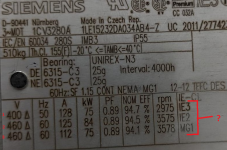celichi
Lifetime Supporting Member
Hello All,
I hope we are all doing great and have a healthy and happy 2023!!
I was wondering if anyone could help me decode this Motor Name Plate.
I am trying to setup the 753 Parameters as part of the Quick Start / Static Tune.
The NP has 3 rows, and I am not sure which values to use.
Why are there 3 rows, and how do I know which one is correct...?
Kind regards - Paul

I hope we are all doing great and have a healthy and happy 2023!!
I was wondering if anyone could help me decode this Motor Name Plate.
I am trying to setup the 753 Parameters as part of the Quick Start / Static Tune.
The NP has 3 rows, and I am not sure which values to use.
Why are there 3 rows, and how do I know which one is correct...?
Kind regards - Paul






